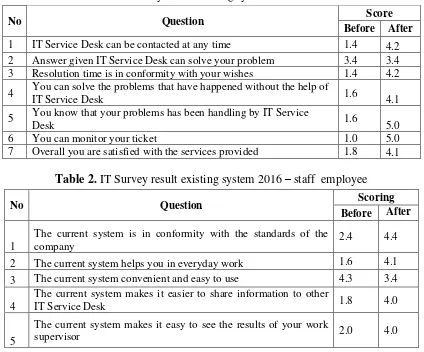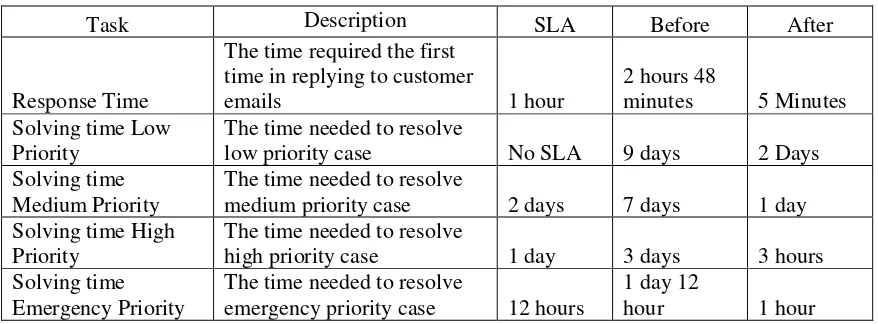IOP Conference Series: Materials Science and Engineering
PAPER • OPEN ACCESS
Implementation helpdesk system using information technology
infrastructure library framework on software company
To cite this article: Abba Suganda Girsang et al 2018 IOP Conf. Ser.: Mater. Sci. Eng.420 012106
View the article online for updates and enhancements.
1234567890‘’“”
2nd Nommensen International Conference on Technology and Engineering IOP Publishing
IOP Conf. Series: Materials Science and Engineering 420 (2018) 012106 doi:10.1088/1757-899X/420/1/012106
Implementation
helpdesk
system
using
information
technology
infrastructure library framework on software company
Abba Suganda Girsang1, Yohan Kuncoro1, Melva Hermayanty Saragih2,
Ahmad Nurul Fajar3
1Computer Science Department, BINUS Graduate Program-Master of Computer
Science, Bina Nusantara University,Jakarta, Indonesia 11480.
2Management Department, BINUS Business School Undergraduate Program,
Bina Nusantara, University, Jakarta, Indonesia 11480.
3Information Systems Management Department, BINUS Graduate
Program-Master of Information Systems Management, Bina Nusantara University Jakarta, Indonesia 11480.
[email protected], [email protected], [email protected], [email protected]
Abstract. As a company which relates its customer service, a software company (this case is PT Boon Software) is induced to give the good service to its customer. The existing information technology (IT) system service is made by patchwork. It brings some problems in service catalog, problem managment, change management, and service level agreement (SLA). The purpose of this research is to implement helpdesk system to software company with Information Technology Infrastructure Library (ITIL) framework as a standard reference to solve various problem related information technology service on a company. This research starts by investigation all stakeholders of the company with some questionnares. Implementation ITIL is strated by finding the gap between the current condition and the standard base line in ITIL. After implementation IT service using ITIL, the stakeholders are asked the same questionnares. The result shows that there is significant different before and after implementing system service using ITIL.
1.Introduction
2 1234567890‘’“”
2nd Nommensen International Conference on Technology and Engineering IOP Publishing
IOP Conf. Series: Materials Science and Engineering 420 (2018) 012106 doi:10.1088/1757-899X/420/1/012106
continue to use its services. To be in the forefront among the competitors with similar services, PT. Boon Software needs to maintain and improve the quality of their IT services.
Handling IT services, PT. Boon Softwarecurrently is still using manual method that has many weaknesses and does not answer the challenges that exist as in this below case. Service catalog, IT service catalog is not available so the user does not know what services IT can provide to the users that have an impact on the slow pace of the IT Service Desk. Problem management records only problem without priority to the problem that occurred. Change management, changes that exist are not recorded whether these problems cause disruption to the entire IT services. Service level agreements (SLA), service level of each problem does not exist or has not been defined. By aferementioned problem, it is decided to implement IT service desk using Infrastructure Library (ITIL) framework in the Company PT. Boon Software. This research is expected to solve the IT service in this company
2.Related Work
Information Technology Infrastructure Library (ITIL) itself has several processes which are the business perspective, IT infrastructure management, planning to implement service management, application management, security management, service management [1][2][3][4]. IT service management (ITSM) is a framework (framework) to manage the IT
Information system audit is defined as a process of collecting and evaluating evidence to assess whether the information system has ensured support management of data, achieve the objectives of an organization effectively, and have been using resources efficiently. In this study, information systems audit with ITIL to assess existing IT service management. ITIL version 3 framework was used as a guide in preparing the operational steps so that the continuity of IT services can work properly. ITIL framework has focused the development of IT governance, especially in terms of services (IT service) and ideal to use as a guide in developing a governance because of its best practices and a detailed library to develop the steps in the procedure [9][2]. IT governance considers two things: the added value of IT to the business and IT risk mitigation. The value of IT is driven by strategic alignment of IT and business, while the risk mitigation driven by responsibility to the organization. Both require the support of sufficient resources and can be measured to ensure the desired results are met.
1234567890‘’“”
2nd Nommensen International Conference on Technology and Engineering IOP Publishing
IOP Conf. Series: Materials Science and Engineering 420 (2018) 012106 doi:10.1088/1757-899X/420/1/012106
must also be well received by everyone and are not accepted by such rigid process[1]. Implementation of ITIL should ensure the smooth functioning of business services and should not be burdening business services.
3.Proposed Method for IT Help Desk
The proposed method is to design IT help desk to handle the manual process in input data or information. Problems areidentified and then used to plan the right solution for solving the problem. Some problems found can be identified as follows.
a. Service catalog, IT service catalog is not available so the user does not know what services IT can provide to the users that have an impact on the slow pace of the IT Service Desk.
b. Problem management, problem management records only problem no priority to the problem that occurred.
c. Change management, changes that exist were not recorded whether these problems cause disruption to the entire IT services.
d. Service level agreements (SLA) was service level of each problem is not defined.
Business gap analysis is used to determine what steps need to be taken to move from the current state to the desired condition. A gap analysis can also be interpreted as a comparison of actual performance with potential performance or expected. As a method, a gap analysis is used as an evaluation tool business to see the difference between the company's current performance with the targeted performance. This analysis also identifies what measures are needed to reduce the gap, or achieve expected performance in future periods. Moreover, this analysis also estimates the time, cost and resources needed to achieve the expected state of the company. A gap analysis consists of three main factors, namely components: a list of characteristics (such as the level of performance) of the present situation, a list of desired improvement in the future, and a list of what gaps exist and the future. Gap analysis will lead to the organization or company to reflect the status and capabilities of what is currently owned by the organization and want to be asked where in the future. The original objectives of the gap analysis are: gathering requirements of the company, determining adjustments (customization) is required, ensure the new system meets the needs of enterprise business processes, ensuring that business processes will be best practice, and identify the problems that require changes in company policy. In this study, population are employees of software companywhich relates to manage engine “OsTicket” in the central office. The survey and the questionnaire are spread for all stakeholders of this company. This company has 40 employees and 20 loyal cutomers. The 40 employees consists 30 the staff employees and 10 mangement employees. Therefore they can be represented as the population of this company. To determine the number of samples, this research uses a method Slovin that is shown in Eq. (1)
𝑛 = 𝑁
1 + 𝑁𝑒2
(1)
4 1234567890‘’“”
2nd Nommensen International Conference on Technology and Engineering IOP Publishing
IOP Conf. Series: Materials Science and Engineering 420 (2018) 012106 doi:10.1088/1757-899X/420/1/012106
research. To be able to give an answer that describes the actual situation, then this questionnaire must be clear, unambiguous and can be used by all respondents to avoid or minimize the possibility of misunderstanding by respondents. The scale of measurement used in this questionnaire is likert scale. Likert scale using intensity values of 1 - 5. This scale defines the level of confidence of respondents from each of the questions:
Answers can be given to the value, for example: 1. Strongly Agree / Always / Very Positive values of 5 2. Agree / Frequent / Positive values 4
3. Undecided / Sometimes / Neutral grades 3 4. Disagree / almost / Never / Negative value 2
5. Strongly Disagree / Never / Very Negative value of 1
4.Result Analysis
Table 1, 2, and 3 show the survey result comparison before and after implementing SLA in service desk using ITIL. Table 1, 2 and 3 are for customer, staff and management, respectively. Data had taken at random from the emails for 2016 from an average of 100 emails. Mostly, each categories respondent has a similar answer. Before implementation the entire handling helpdesk applications still using manual (via email) and no recording in real SLA, the value before implementating tends to be small. At the end, the comparison is performed between the current system SLA OS ticket system and after implementation of ITIL as shown in table 4.
Table 1. IT Survey result existing system 2016 – customer
No Question Score
Before After
1 IT Service Desk can be contacted at any time 1.4 4.2 2 Answer given IT Service Desk can solve your problem 3.4 3.4 3 Resolution time is in conformity with your wishes 1.4 4.2
4 You can solve the problems that have happened without the help of
IT Service Desk 1.6 4.1
5 You know that your problems has been handling by IT Service
Desk 1.6 5.0
6 You can monitor your ticket 1.0 5.0
7 Overall you are satisfied with the services provided 1.8 4.1
Table 2. IT Survey result existing system 2016 – staff employee
No Question Scoring
The current system makes it easy to see the results of your work
1234567890‘’“”
2nd Nommensen International Conference on Technology and Engineering IOP Publishing
IOP Conf. Series: Materials Science and Engineering 420 (2018) 012106 doi:10.1088/1757-899X/420/1/012106
Table 3. IT survey result existing system 2016 – management employee
No Question
Scoring Before After
1 The current system can generate the required management report 1.4 4.0 2 The current system is able to make the customer satisfied 1.0 4.4
3 Management, can be done systematically making it easier for support teams keeping procedures. Change Management, any changes that are in the system will be recorded properly, so do the observation and evaluation of all forms changes. Service Level Agreement (SLA), an increase in services provided to users
There are some parts of ITIL which have not been implemented in this study such as financial management, supplier management, information security management are planned to be carried out on the second step.
6.References
[1] Great Britain. Office of Government Commerce., Introduction to ITIL. 2005. [2] D. Cannon and D. Wheeldon, ITIL Service Operation. 2007.
[3] C. Taylor, S. Lloyd , and V. Rudd, “Service Strategy ITIL v3,” Online, p. 276, 2007. [4] M. Vicente, N. Gama, and M. M. Da Silva, “Using ArchiMate and TOGAF to
understand the enterprise architecture and ITIL relationship,” in Lecture Notes in
Business Information Processing, 2013, vol. 148 LNBIP, pp. 134–145.
6 1234567890‘’“”
2nd Nommensen International Conference on Technology and Engineering IOP Publishing
IOP Conf. Series: Materials Science and Engineering 420 (2018) 012106 doi:10.1088/1757-899X/420/1/012106
[6] J. V. Bon, “Foundations of IT Service Management based on ITIL V3,” ITIL Libr., vol. 1, p. 234, 2007.
[7] V. D. Love and L. R. Ness, “Integrating ITSM into the Corporate Environment,” J.
Heal. Care Compliance, vol. 18, no. 3, pp. 5–12, 2016.
[8] Y. Peng et al., “Automating ITSM incident management process,” 2006 IEEE/IFIP
Netw. Oper. Manag. Symp. NOMS 2006, vol. 3, no. 11, pp. 583–590, 2008.
[9] M. Brenner, “Classifying ITIL Processes; A Taxonomy under Tool Support Aspects,”
2006 IEEE/IFIP Bus. Driven IT Manag., vol. 00, no. C, pp. 19–28, 2006.
[10] R. Pereira and M. Mira da Silva, “A Maturity Model for Implementing ITIL V3 in Practice,” in 2011 IEEE 15th International Enterprise Distributed Object Computing

